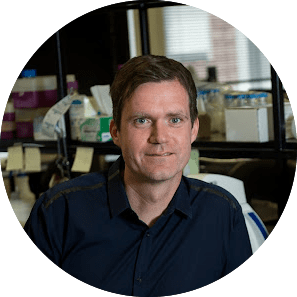
Dr. Lars Dietrich, PhD
Associate Professor of Biological Sciences
Dr. Dietrich teaches the Project Lab in Microbiology, a course for senior undergraduate students who are interested in hands-on research experience that introduces them to the beauty and diversity of the microbial world. The course meets formally for four hours, twice a week. Up to one hour per week is devoted to lectures and general discussion. The remaining time is spent in the laboratory carrying out the research. Most students also stop into the lab for 1-2 hours per week outside of the official meeting times to monitor their ongoing experiments.
For the first class module, students collect samples from the Columbia University campus, isolate bacteria, and determine their identities using molecular techniques (See Image A). The students then conduct a variety of assays to characterize the bacteria and summarize their observations and results in an oral presentation. For the second part of the class, the students take on an independent research project with unknown outcomes. This effort includes mutagenesis of a bacterium and identifying genes that are involved in mediating specific metabolic processes.
Read on to learn more about what Dr. Dietrich did in his courses, what lessons and experiences he’s carrying forward, and the advice he has for other instructors at Columbia.

Image A: Bacterial that students isolated from Columbia’s Morningside Campus grown as colonies on agar plates. Each colony is roughly the size of a dime. The bacteria produce pigments and form intriguing multicellular patterns.
Engage Students across All Modalities
As one can imagine, the course is demanding for the teaching assistants (TAs), who organize and prepare all of the practical aspects of the research and also serve as mentors to the students. The hands-on, independent, and open-ended aspects of the course are exciting for the students, the TAs, and me. I have conducted the course for more than 10 years and every year, students make unexpected discoveries and theoretical connections that stimulate our thinking and make teaching and mentoring very rewarding for us as the instructors.
When COVID hit in 2020 and Columbia shifted to fully online instruction, it at first seemed impossible to come up with a way to conduct the Project Lab in Microbiology course because it is so hands-on. Then, for summer 2020, the administration put policies in place that would allow us to offer in-person instruction to eight students (half our usual enrollment). This made the TAs and me wonder: Might it be possible to have an enriching research experience over Zoom? We decided to try it: we enrolled eight in-person students in the course, and each was paired up with a student who would be taking the course virtually. The in-person students would perform all of the hands-on work with their partner watching over Zoom on an iPad that was attached to an adjustable holder at each bench. This arrangement had the additional benefit of allowing students to participate in the course even if they could not attend it in person for health reasons or because of travel restrictions.
Promote Student Growth through Structured Collaboration
It was inspiring to see how the in-person students managed their roles in each duo – by positioning the iPad on the bench, demonstrating techniques, and holding samples up to the camera so that their partners could see everything first-hand in and in real-time. Connecting over Zoom added a new challenge to the course that promoted students’ growth because it required a level of definitive communication about observations and conclusions that does not always occur in person. It also required a greater degree of understanding and organization for the in-person students and of focus and observation for the virtual students. Based on student performance, the hybrid pairing format was highly effective; viewing the presentations and reports prepared by students in the course, an objective observer would not be able to tell which students took the class in person, and which participated virtually. The success of this arrangement was reflected in excellent evaluations (and added bonus was that we had no COVID cases, let alone spreading events).
Advice for Instructors and the Future of Teaching at Columbia
Leverage the power of student interaction.
My main takeaway from this pandemic teaching experience, and what I would advise other instructors to leverage in their own courses, is the power of student interaction–even or especially via a camera—while they make observations and interpret and explain what they’ve learned. Discussion between students promotes understanding of basic concepts and the formulation of new ideas, and (unexpectedly) the hybrid format enhanced this in my experience.
After seeing this arrangement work, I am eager to now apply it in other contexts. There is an element of excitement in basic research that is missing from protocol demonstrations and that is lost when findings are reported months or years after the first observation. However, hands-on laboratory research is not accessible for many people for a variety of reasons (geographical location, health restrictions, schedule restrictions). Virtual observation can allow these individuals to witness scientific discovery in real-time, and we are planning outreach activities that will offer this experience to a broad audience.